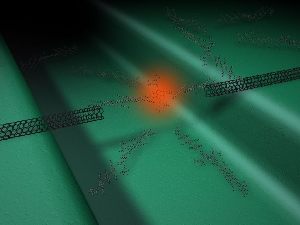Work performed by the research teams of the chemist Professor Marcel Mayor (KIT and UB) and the physicists Dr. Ralph Krupke (KIT) and Professor Hilbert v. Löhneysen (KIT) contributes decisively to the development of new optoelectronic components based on individual molecules. In this process, tailored molecules with a luminescent core are placed between carbon nanotube electrodes and triggered electrically. Molecular electroluminescence is proved by the spectroscopic fingerprint of the molecule. Both the molecules and the carbon nanotube electrodes were specially developed for this process by the scientists.
Molecular electronics focuses on charge transfer through molecules. The long-term objective is to develop molecular circuits for high-performance and energy-efficient computers. It is confirmed by the present project that individual, hard-wired molecules may be excited electrically to luminesce. This major fundamental research finding extends the vision of molecular electronics by an optoelectronic component.
The challenge faced by the researchers was to integrate so-called bottom-up structures (molecules) in top-down structures (electrodes) and to manage the critical dimensions. To ensure charge transfer and light emission, the electronic and optical properties of the molecule and nanotube electrodes have to be adapted to each other.
These requirements were met by the 7.5 nm long rod-shaped molecules with a light-active core synthesized by Dr. Sergio Grunder and Dr. Alfred Błaszczyk and the carbon nanotubes processed by Dr. Frank Hennrich in the working group of Professor Manfred Kappes (KIT). By means of controlled current-induced oxidation, Dr. Christoph W. Marquardt succeeded in generating nanotube electrodes with a minute gap (< 10 nm). The molecules in the solution are precipitated between the nanotube electrodes by means of dielectrophoresis, a field-induced type of self-organization.
Special anchor groups at the molecules ends provide for sufficient stability of the nanotube-molecule-nanotube junctions. If a voltage of a few volts is applied to such a junction, the molecule luminesces. With the help of a sensitive microscopic setup, the researchers detected this light and proved that it is emitted by the core of the molecule. The work will be published as Advanced Online Publication (AOP) in the renowned Nature Nanotechnology journal.
Literature:
Christoph W. Marquardt, Sergio Grunder, Alfred Błaszczyk, Simone Dehm, Frank Hennrich, Hilbert v. Löhneysen, Marcel Mayor, and Ralph Krupke: Electroluminescence from a single nanotube-molecule-nanotube junction. Nature Nanotechnology, published online November 28, 2010 | doi 10.1038/NNANO.2010.230
Being “The Research University in the Helmholtz Association”, KIT creates and imparts knowledge for the society and the environment. It is the objective to make significant contributions to the global challenges in the fields of energy, mobility, and information. For this, about 10,000 employees cooperate in a broad range of disciplines in natural sciences, engineering sciences, economics, and the humanities and social sciences. KIT prepares its 22,800 students for responsible tasks in society, industry, and science by offering research-based study programs. Innovation efforts at KIT build a bridge between important scientific findings and their application for the benefit of society, economic prosperity, and the preservation of our natural basis of life. KIT is one of the German universities of excellence.

